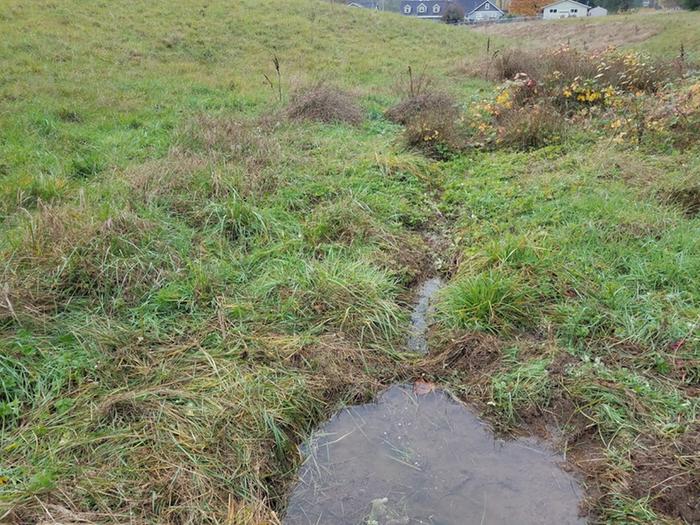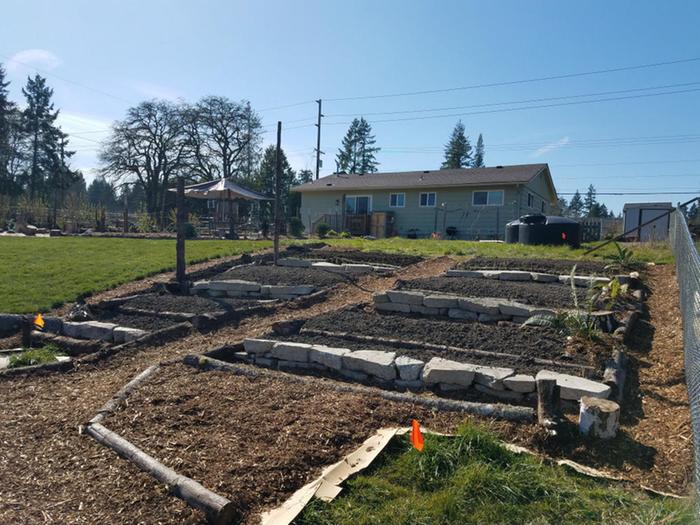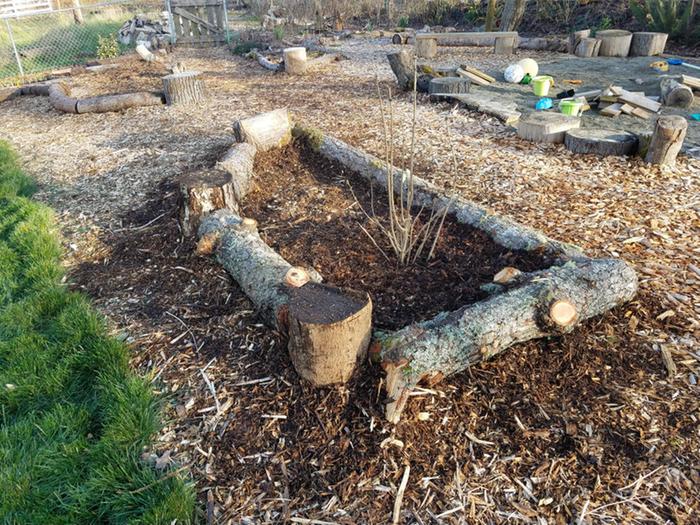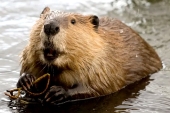I thought it was about time I give you all an update on some of my new/ongoing projects. The first is a new garden area for my kids!

But it's not just a garden--it's also an area for family walks, an area for wildlife, and an area for perennial food growing.
This garden is along the bottom of my eco-lawn and is broken into a couple different areas. Starting along the chain fence this first long growing bed is going to be planted with mostly perennial food plants. At the moment there is a thornless blackberry, a serviceberry, a silverberry, and a grape. But I will be adding a lot more plants including some asparagus later on. I will also be adding a bench to make it a nice place to hangout. I will also be adding ground cover plants and other herbaceous plants but I'm not sure which yet.
Next to the perennial growing area is a winding mulched path. The edge of this path is lined by logs I salvaged from a prairie restoration site. These logs make it easy for visitors to know where to walk but they also provide great habitat for beneficial critters. I'm always finding centipedes under logs like these! Centipedes eat a lot of the pests that cause problems in gardens! I also added some large rounds for extra places to sit and to mix things up a bit.
The next bed is the future garden bed for my kids. This bed is fairly small and will be a small hugelkultur bed--at the moment I have the wood down but I still need to get soil to finish it. While small this garden should work well--I wanted to make it small enough that my kids could reach everything. I grew up with my own garden beds and I want my kids to have the same experience. I loved planning out my own garden and harvesting from it each year. My daughter is too young to engage with it right now but I'm sure she will enjoy it and my son who will be 3 in February is super excited about this garden!
Next to the garden bed is what will be another small hugelkultur bed but this one will be filled with flowers. The flowers will provide beauty and cut flowers but also provide habitat for pollinators and help attract beneficial insects to help keep pests under control. This bed is the closest to the lawn and will make a nice boarder that will be beautiful to see.
I also put in a couple habitat features. In one area the beds were getting too wide so I made a third bed in the middle that I just mulched and then added logs and rocks to make a great little habitat area for beneficial critters like garter snakes. I also added 2 tall snags which mark the extent of the kids garden area but also serve as perches for birds. I see birds using our existing snags a lot! I'm thinking about attaching some mason bee boxes to these 2 snags.
I got more work to do on this new growing area but I'm really excited about it! Once it's all in and growing good I think this will add a lot to my wild homestead!
Check out the first 3 attached pictures to see what this new garden area looks like.
-----------------------------------
Moving on from that garden bed... to another new garden bed!

This new garden bed (4th attached picture) is located along the south side of my house. It is a modified key-hole bed and a hugelkultur bed.
This garden bed is raised a fair bit which will help keep it warmer and since it's along the south side of my house it should stay nice and warm. I have noticed that this area tended to frost late and warm up much early in spring than other areas of my land. Frost tender plants kept growing here much longer than they did in other areas. This was why I decided to completely redo this area and build a large raised garden bed.
The garden bed will be used for growing peppers, tomatoes, egg plants and basil. But I will also be using it to get an early start on other plants like snap peas and various greens.
While it's not a big growing area it adds to my other garden beds and should give me early and late harvests compared to my other beds. I like having different growing areas that have their own micro-climates so I can use those micro-climates to get harvests over a longer time period.
Right along the house I have a couple purple tree collards that are doing okay but were a bit neglected. I finally got them tied up so they won't be falling down all the time. But I may need to prune them up a bit. I will be adding a bunch of flowers next to the tree collards to help fill in that area and attract beneficial insects. I have had some issues with caterpillars eating my tree collards so I'm hoping the flowers will help attract insects that will eat the caterpillars. Plus the flowers will add a lot of beauty to this area!
I got to add soil to this new garden bed and some additional wood. But it's moving along and I'm excited to have this new growing area!
-----------------------------------
The last attached picture is an old but ongoing project and that is my little water catchment channel that I built to get runoff from a shared dirt/gravel driveway. This channel captures most of the water from around 220 feet of driveway and the runoff from the roof of my neighbors house. At times this is a lot of water!
I created this feature a couple years ago but I recently improved it and I will be making this channel larger and making it look like a dry streambed. This will make it look nice and make it where I don't need to dig out grass from it every year.
The channel goes into a deep mulch pit surrounded by willows. This pit overflows into an old pasture area. Eventually it will overflow into a swale which will be part of a whole swale system and a pond or natural swimming pool. Around this swale system I will be building a series of large garden beds for high vegetable production plus some fruit trees and hedgerows. I'm also planning on establishing a decent size native meadow--I will be adding some bee hives to this meadow area too but that is a ways off.
This project is still in it's early stages but is already capturing a lot of runoff!

-----------------------------------
Lots of work but also lots of fun and I can't wait to have more growing areas! I'm also working on a series of terraces which will be used to grow corn, squash and other crops that need more room plus a couple potato beds. More on that soon!

 6
6











 It's exactly what I need to go beside my rain barrels. What are the rough dimensions of this shed?
It's exactly what I need to go beside my rain barrels. What are the rough dimensions of this shed?



It's exactly what I need to go beside my rain barrels. What are the rough dimensions of this shed?
 The shed is approximately 5.5 feet high, 2 feet deep and 3.5 feet wide.
The shed is approximately 5.5 feet high, 2 feet deep and 3.5 feet wide.


 5
5




 2
2








 1
1







 8
8















 1
1







 2
2




 But it's not just a garden--it's also an area for family walks, an area for wildlife, and an area for perennial food growing.
But it's not just a garden--it's also an area for family walks, an area for wildlife, and an area for perennial food growing.
 This new garden bed (4th attached picture) is located along the south side of my house. It is a modified key-hole bed and a hugelkultur bed.
This new garden bed (4th attached picture) is located along the south side of my house. It is a modified key-hole bed and a hugelkultur bed.









 1
1











































